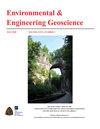泥石流和泥石流易感性制图用于地质灾害风险排序
IF 0.7
4区 工程技术
Q4 ENGINEERING, ENVIRONMENTAL
引用次数: 3
摘要
区域尺度的泥石流、泥石流传播和扇上的崩解评估是具有挑战性的。基于航空或卫星图像的地貌测绘需要大量的实地验证工作。过去事件的地表证据可能会被开发或被重复侵蚀或碎片淹没所掩盖,并且可能需要沟槽来记录沉积结构和确定过去事件的日期。本文评估了一种基于数字高程模型(DEM)指标组合的区域尺度泥石流和泥石流易感性制图方法,以识别潜在的碎屑源区域,并使用flow - r代码进行流传播建模,该代码通过与绘制的冲积扇进行比较来校准。DEM指标可以实现半自动识别和初步的、基于过程的分类,这些分类容易发生泥石流和泥石流。flow - r是一种敏感性制图工具,它基于扩展和跳动算法的结合,考虑DEM地形和经验传播参数,对潜在的水流淹没进行建模。该方法首先在泥石流和泥石流洪水灾害已经根据实地测绘和详细数值模拟评估过的地点进行评估。然后将其应用于加拿大不列颠哥伦比亚省南部12.5万平方公里的区域。应用该方法的动机是,它代表了一种客观和可重复的易感性绘图方法,可以将其集成到区域尺度的泥石流和泥石流洪水风险优先排序框架中,以支持风险管理决策。本文章由计算机程序翻译,如有差异,请以英文原文为准。
Debris-Flow and Debris-Flood Susceptibility Mapping for Geohazard Risk Prioritization
Regional-scale assessments for debris-flow and debris-flood propagation and avulsion on fans can be challenging. Geomorphological mapping based on aerial or satellite imagery requires substantial field verification effort. Surface evidence of past events may be obfuscated by development or obscured by repeat erosion or debris inundation, and trenching may be required to record the sedimentary architecture and date past events. This paper evaluates a methodology for debris-flow and debris-flood susceptibility mapping at regional scale based on a combination of digital elevation model (DEM) metrics to identify potential debris source zones and flow propagation modeling using the Flow-R code that is calibrated through comparison to mapped alluvial fans. The DEM metrics enable semi-automated identification and preliminary, process-based classification of streams prone to debris flow and debris flood. Flow-R is a susceptibility mapping tool that models potential flow inundation based on a combination of spreading and runout algorithms considering DEM topography and empirical propagation parameters. The methodology is first evaluated at locations where debris-flow and debris-flood hazards have been previously assessed based on field mapping and detailed numerical modeling. It is then applied over a 125,000 km2 area in southern British Columbia, Canada. The motivation for the application of this methodology is that it represents an objective and repeatable approach to susceptibility mapping, which can be integrated in a debris-flow and debris-flood risk prioritization framework at regional scale to support risk management decisions.
求助全文
通过发布文献求助,成功后即可免费获取论文全文。
去求助
来源期刊

Environmental & Engineering Geoscience
地学-地球科学综合
CiteScore
2.10
自引率
0.00%
发文量
25
审稿时长
>12 weeks
期刊介绍:
The Environmental & Engineering Geoscience Journal publishes peer-reviewed manuscripts that address issues relating to the interaction of people with hydrologic and geologic systems. Theoretical and applied contributions are appropriate, and the primary criteria for acceptance are scientific and technical merit.
 求助内容:
求助内容: 应助结果提醒方式:
应助结果提醒方式:


